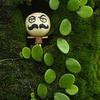Wednesday
Noon
I walk out of Chuo Shokudo San Bou with my stomach full of veggies, ready to start exploring the town of Koya. But first, I go to the Koyasan Shukubo Association (Tourist Information) Central Office around the corner to rent an audio guide (500 yen). Since I am staying the night in town, they tell me I could return the audio guide the following morning in the same office or in any of the two tourist information centers near Okunoin. (Day trippers have to return the audio guide on the same day, before the offices close at 430PM.)
I switch on my audio guide and listen to a short introduction about Koyasan as I walk westward to my first stop: Kongobuji Temple, a UNESCO World Heritage Site.
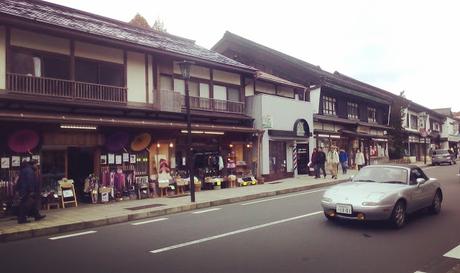 The town of Koya
The town of KoyaKongobuji
金剛峯寺830AM to 5PM (last entry at 430PM)Admission fee: 500 yen (400 yen if with Koyasan World Heritage Ticket 20% discount coupon)
Kongobuji is the head temple of Shingon Buddhism. I enter the temple grounds through its main gate which is the oldest building (1593) in Kongobuji. In the past only royalty and the chief priests could pass through this gate. Today, everyone can pretend they are royalty.
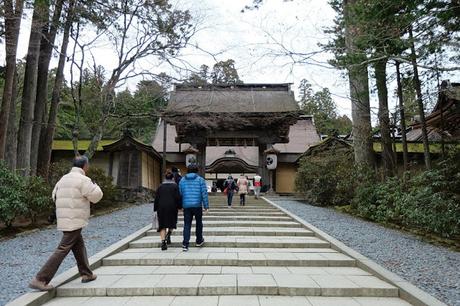 Kongobuji's main gate
Kongobuji's main gateInside the temple grounds, to the left of the gate, I see a small lonely building surrounded by trees. This is the kyozo (1679), a storage for all the temple's important articles. There is moss growing on its roof. It is closed. I wonder if it's musty inside.
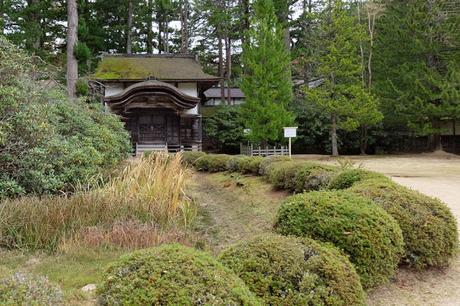 Kyozo (Scripture Storehouse)
Kyozo (Scripture Storehouse)To the right of the gate, the audio guide tells me, is the shoro or bell tower. I can't see the bell because it is a bell tower with walls, a type that is called hakamagoshi. I wonder if its bell is still being rung and when?
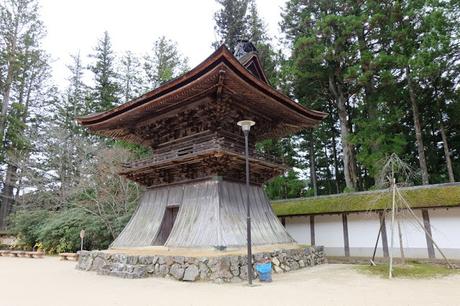 Shoro (Bell Tower)
Shoro (Bell Tower)And directly in front of me, Kongobuji with its thick thatch roof...and, strangely, wooden buckets on the roof. I learn that these buckets are called tensuioke or rain barrels... you know, in case of fire.
The temple has two entrances. The main entrance, like the main gate, is only for royalty and for the chief priests. This is fenced off: no entry! I and the other visitors enter through the smaller entrance and pay the admission fee. The temple is quite big and I walk slowly from room to room, listening to my audio guide and following the map of Kongobuji on the brochure that came with it.
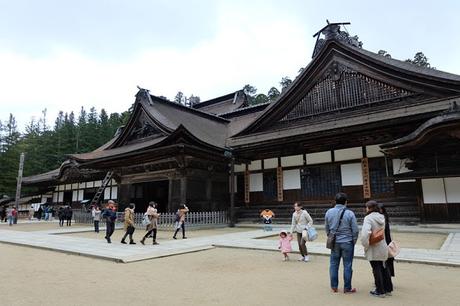 Kongobuji
KongobujiFirst a spacious room with paintings of pine trees and cranes on its golden fusuma (sliding doors). This room is the Ohirama or the Main Hall where important ceremonies are held. Also in this room is the Jibutsuma, an altar where Kobo Daishi, the founder of Shingon Buddishm, is enshrined. The altar also has memorial tablets for past emperors of Japan and Chief Abbots of Kongobuji.
After the main hall, I admire six more smaller rooms with painted sliding doors; one room's fusuma is painted with plum trees, the other with willow trees, others with sceneries.
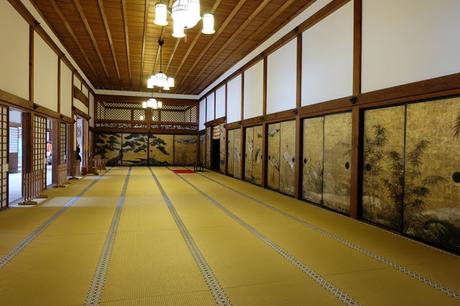 Ohirama (Main Hall)
Ohirama (Main Hall)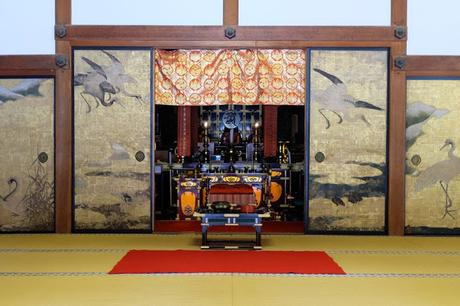 Jibutsuma
JibutsumaMoving on to spot #10 on my map, the Shin Betsuden. But before I enter, I am given a tray of green tea and rice cracker. I follow my fellow visitors into Shin Betsuden and sit on the side. Since I can't understand a word of what the monk is saying, I just munch on the cracker and drink my tea, then slowly tiptoe away once I'm done.
 Shin Betsuden (New Temple Annex)
Shin Betsuden (New Temple Annex)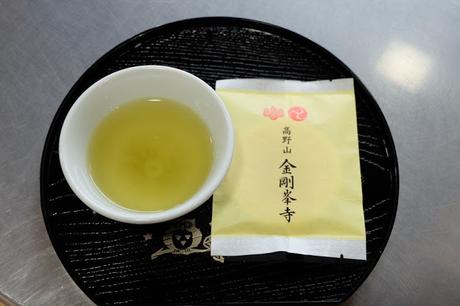
I move further west in the temple and a very large and beautiful rock garden stops me in my tracks. Banryutei Rock Garden, measuring 2,340 square meters, is the largest rock garden in Japan. I try to imagine two dragons emerging from a blanket of clouds...because that is what this rock garden is supposed to represent.
 Banryutei Rock Garden
Banryutei Rock GardenI visit a few more rooms in the temple: the golden room called Shoin Jodan no Ma where Koyasan's major ceremonies are held; Okushoin, which used to be the resting area of the Imperial Family; Chigonoma, or the page room, where guards of the emperor stayed; Tsuchimuro, a room that was built coated with soil and a fireplace in the center; and, lastly, the huge kitchen where one can cook up a storm and feed up to 2000 people.
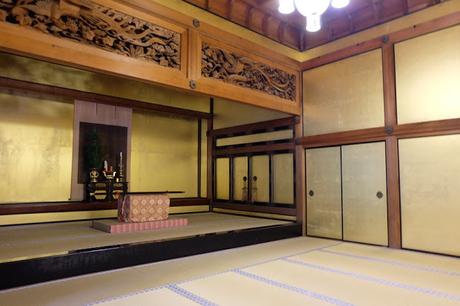 Shoin Jodan no Ma
Shoin Jodan no Ma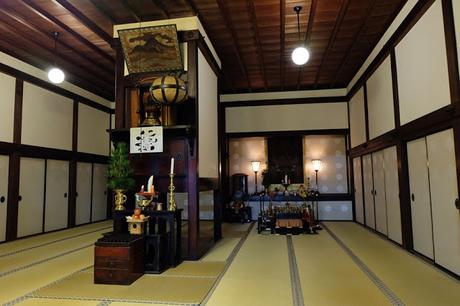 Tsuchimuro (Earth Room)
Tsuchimuro (Earth Room)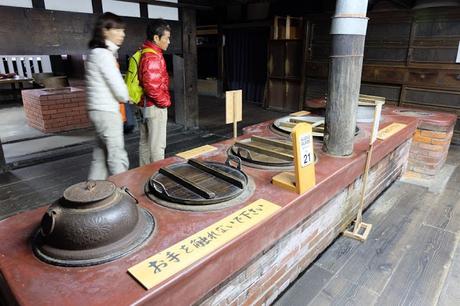 Kitchen
KitchenGaran
壇場伽藍Garan Grounds: Open all day / Free admissionKondo Hall / Konpon Daito Pagoda:830AM to 5PM200 yen each (160 yen each if with Koyasan World Heritage Ticket 20% discount coupon)Note: The fee is dropped in an unmanned box, so prepare the exact amount.
I leave Kongobuji and go to Koyasan's central temple complex called Garan. This is one of two of Koyasan's most sacred sites (the other is Okunoin, which is on the east side of town, near where I am staying). Garan is the first site Kobo Daishi built when he first started the monastery on Mt Koya.
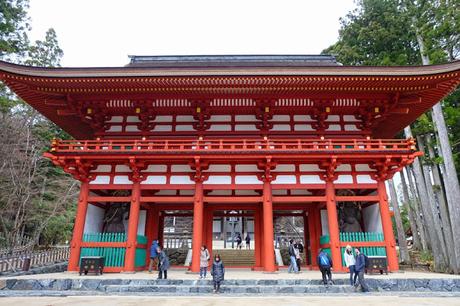 Chumon
ChumonThe temple complex has a gate (Chumon), but I enter on the east side of the complex where it is nearer to Kongobuji.
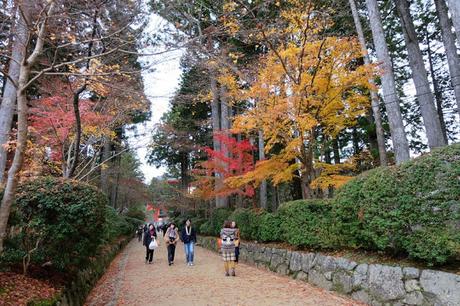 The pathway that leads to the east side of Garan
The pathway that leads to the east side of GaranI see a small red and white pagoda called Toto or East Pagoda on my right, followed by three faded wooden buildings of different shapes and sizes: Sanmaido, Daiedo, and Aizendo. All these are closed.
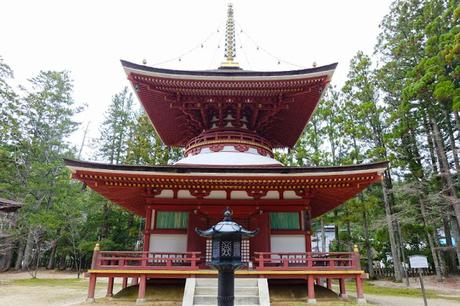 Toto (East Pagoda)
Toto (East Pagoda)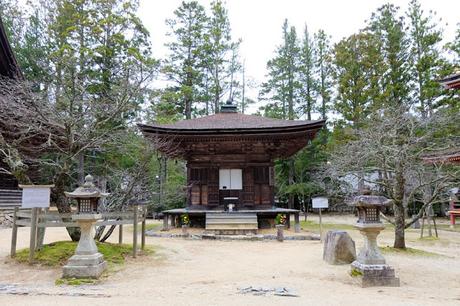 Sanmaido
Sanmaido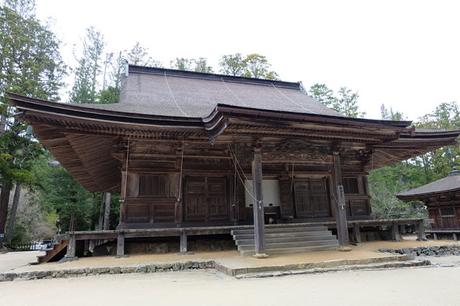 Daiedo
Daiedo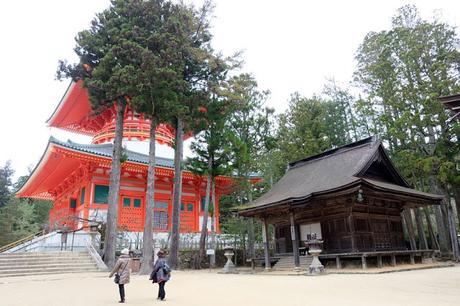 Konpon Daito (left) and Aizendo (right)
Konpon Daito (left) and Aizendo (right)Opposite the Aizendo is another wooden building called Fudo-do. This is the oldest building in Koyasan, built in 1198. While I look at Fudo-do and wonder what's inside (this, too, is closed), I hear a chorus of voices, a captivating chant, and I hurry away to find the source.
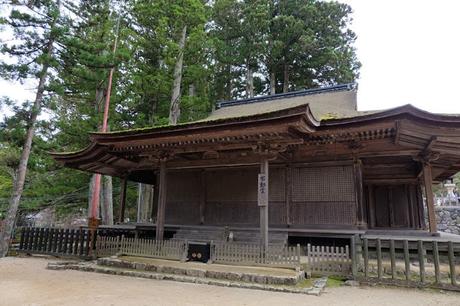 Fudo-do
Fudo-doThe enchanting sound comes from a group of monks gathered in front of Konpon Daito and I catch the last lulling notes as I reach them.
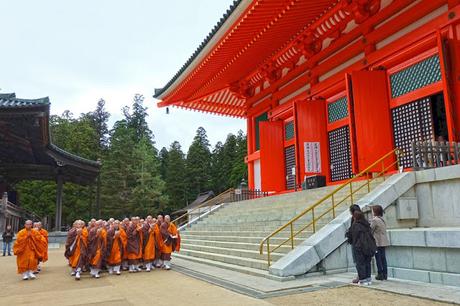
Construction of the Konpon Daito was started in the year 816 and was finished 71 years later. The pagoda is about 50 meters high and inside are Buddhist images and statues. Another building I enter is the Kondo or the main hall. This is where many ceremonies and rituals take place. (Taking photographs inside these two buildings is not allowed.)
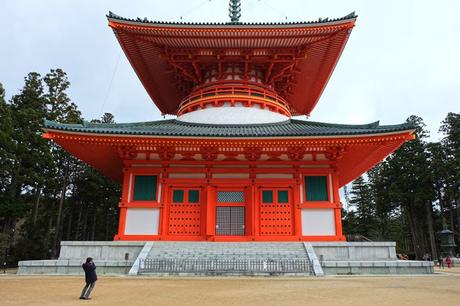 Konpon Daito (Great Pagoda)
Konpon Daito (Great Pagoda)Near these two buildings is a pine tree (Sanko no Matsu) where I notice a lot of people are gathered, some bent at the hip, looking at the ground.
Legend has it that before Kobo Daishi returned to Japan from China, he threw his Buddhist ceremonial tool (called a sankosho) to the east and prayed that it would show him where to build his monastery. It is said that he discovered his sankosho stuck in this pine tree, a type that has three needles.
So why are these people looking at the ground? They are looking for pine needles to keep as a lucky charm. Out of curiosity, I look at the ground too to see if the pine needles really come in threes. (I see a few.)
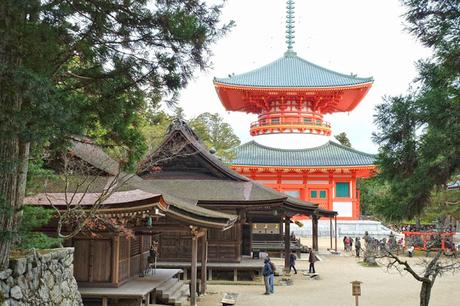 Kujaku-do, Junteido, Miedo, Konpon Daito, Sanko no Matsu (surrounded by a red fence)
Kujaku-do, Junteido, Miedo, Konpon Daito, Sanko no Matsu (surrounded by a red fence)I explore the rest of the temple grounds and see more wooden buildings (all closed to the public) such as the Miedo or the Great Portrait Hall, which contains a 9th century portrait of Kobo Diashi and can only be viewed by the public once a year; Saito or the West Pagoda; and the Rokkaku Kyozo, a beautiful hexagonal building that is said to house Buddhist scriptures written in gold ink on blue paper.
 Saito (West Pagoda)
Saito (West Pagoda) Rokkaku Kyuzu
Rokkaku KyuzuThere are handles on the base of the Rokkaku Kyuzu and I watch as two people struggle to turn it. One rotates the base once he has finished reading the scriptures, but I am guessing these two are just curious how to rotate it. I want to give it a go but I feel I'd look funny doing it alone. I abandon the idea and give the temple complex a 360-degree look before I leave and proceed west to the edge of town.
Daimon
大門I know I am at the edge of town when I reach a two-storey, 25-meter tall gate. This great gate, Daimon, marks the entrance to Koyasan and the end of the 23.5-kilometer Choishi Michi Trail, one of the six pilgrimage trails in the Kii Mountain Range that are inscribed as UNESCO World Heritage Sites. The great gate is flanked by two Nio, or guardians of Buddha. These figures are considered to be the second largest in Japan; the largest ones are in Todaiji in Nara.
 Daimon
Daimon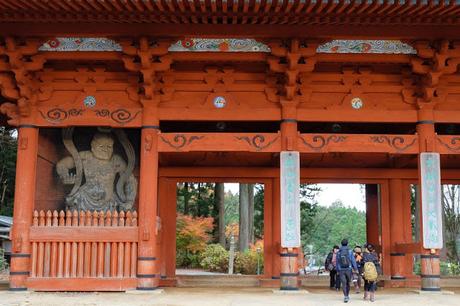 A Nio
A NioNow that I have reached the west end of town, I rest my legs and sit on a bench facing the magnificent gate and enjoy the cool late November mountain air. It is quiet, disturbed only by the sound of a car passing the road that bends around the gate.
Two persons stumble through a small red torii off to my left and I remember it is the hiking trail the guesthouse staff recommended to take if I wanted a short hike (less than an hour). I glance at my watch and see that there is still plenty of time to reach the peak of Mt Bentendake before it gets dark.

I start my hike. The ground is completely covered with brown leaves. Every step I make makes a crunching noise as leaves and twigs break under my big feet. I meet only one person and he is on his way down. I continue on. It's just me and nature. Trees, leaves, bushes, an occasional faded red torii. And then I see a sign. Upon closer inspection, it warns me that bears have been spotted in the area and not to hike alone and to cover my face if I were attacked by a bear. I take a photo of the sign and send it to my family WhatsApp group with the caption "to proceed or to go back?" I go on following the trail.
 Beware of Bears!
Beware of Bears!I am a few hundred meters further up the mountain when I receive my sisters' frantic reply: Go back!!! Her message bops some sense into me and I stop, look around, and think: I am alone. I have not seen anyone else ahead or behind me. I don't have a bell to "scare" the bears. No one knows I'm here except my family and they are thousands of miles away...and maybe that guy who was on his way down, if he even had a good look at my face. Plus I am hungry. I want to feed myself and not be fed to the bears. I take one last look up the lonely path and turn around and go back down to civilization to look for food.
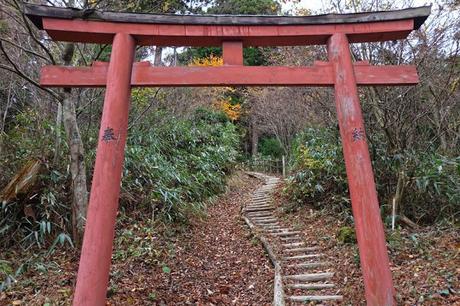
Filling my stomach was more important than visiting these other places in the west side of town:
- Koyasan Reihokan Museum 霊宝館 – a museum of Kongobuji's sacred relics, Buddhist images, and icons. Open from 830AM to 530PM (5PM from November to April). Admission fee is 600 yen (480 yen if with Koyasan World Heritage Ticket 20% discount coupon).
- Tokugawa Clan Mausoleum 徳川家霊台
Japan
Know Before You Go
Single Entry Tourist Visa for Japan
Roam Around Japan with a Swagger
An Ignoramus in Japan: Vending Machines
An Ignoramus in Japan: Bathrooms and Toilets
An Ignoramus in Japan: Manhole Covers
I Spy With My Little Eye: Japan's Fashion Contradictions
I Spy With My Little Eye: On the Go in Japan
From Tokyo to Hiroshima (2015)
10D/9N | Tokyo, Toyama, Kyoto, Hyogo, Osaka, Hiroshima
Tokyo Accommodation: Shinjuku Airbnb
Tokyo: Memorable Tokyo Eats
Tokyo: Odaiba
Tokyo: Doing Touristy Things in Tokyo
Toyama: A Hamlet Called Ainokura
Kyoto Accommodation: K's House Hostel Kyoto
Kyoto, Japanecdote: Wisdom from the Road: On exits #2
Kyoto: By the Thousands (Kyoto Imperial Palace, Sanjusangendo, Fushimi Inari Taisha, Arashiyama Bamboo Grove)
Kyoto, Japanecdote: Turning Japanese
Kyoto: Braving the Crowds at these UNESCO World Heritage Sites in Kyoto (Kiyomizu-dera, Nijo Castle, Kinkakuji)
Hyogo, Japanecdote: If Only I Could Speak Nihongo
Hyogo: Day Trip to Himeji: Himeji Castle and Shoshazan Engyoji Temple
Hyogo, Japanecdote: Am I an Alien?
Hiroshima: Strolling and Snacking in Miyajima
Hiroshima: Remembering the Past in Hiroshima
Osaka, Japanecdote: How to Lose Friends
Osaka Accommodation: Osaka Airbnb
Osaka, Japanecdote: Where is Bentencho Station?
Osaka: Osaka Adlaw, Osaka Ako sa Osaka
Osaka, Japanecdote: Learn From Your Mistakes
Concentrate on Kansai (2016)
9D/9N | Wakayama, Nara, Kyoto, Osaka
UNESCO World Heritage Sites in the Kansai Region
Osaka: Kansai Diaries, Day 0: Arrival
Osaka Accommodations: Hotel Raizan, Hotel Mikado
Wakayama: Kansai Diaries, Day 1: Going to, Sleeping in, and Eating in Koyasan
Wakayama: Kansai Diaries, Day 1½ : West Side of Koya Town (you're here!)
Kyoto Accommodations: Guesthouse Wind Villa, Shiori Yado
